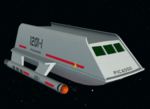Tell that to NASA then. No wings on their rockets, they apparently are doing it wrong.
In the end the whole thing boils down to this: you enter a planets atmosphere. With our present day technology you need to rely on some way to reduce speed. Every space agency for obvious reasons relies on aerobraking: you convert position energy into heat to slow the vehicle down to manageable speeds. The last meters you have to rely on something else. On the SpaceShuttle they resorted to wings for a glide aproach. Anybody else relies on parachutes to slow the speed down enough to land savely.
The pure reason behind that is the tyrany of fuel (Or Tyranny of the Rocket Equation). Look it up, it's an acutal term. It basically means that for every pound of fuel you bring along with you, you need to spend extra fuel in earlier stages. The costs rise exponentially. (Depending on which fuel you use, the fuel makes up between 83% and 96% of a rockets mass. ) So in the theoretical scenario that you want to slow down your spaceship not by aerobreaking but by using thrusters, you'd need to bring a full sized V5 rocket into space. Which means you'd need many of them to carry the one into space. (More exact: considering the best case scenario you'd need to use up 6 of them to carry one into space, which then could use its fuel to slow down when returning. ) Which gets a bit expensive.
In contrast, within the world of ED, every spaceship has a fusion reactor. It means it has an almost unlimited power supply. Fuel in ED is cheap and light. If you have so much energy available, basically for free, there's no reason not to use it for breaking down and controling your ship by thrusters. In the end, that's exactly what we already do on non-atmospheric planets. I mean, what else but our thrusters would slow the ships down?
The only difference for atmospheric planets actually is: depending on your speed, you still have to handle things like compression heat, turbulences, the sonic shockwave, etc. And yes, those can differ strongly depending on each ships shape. But the answer also was already given in this thread: we have shields. A shield strong enough to keep my ship alive when ramming a planets surface at over 500 m/s and a ship able to collect fuel by entering a suns corona should also be able to handle some compression heat, turbulences and a bit of sonic shockwaves.

